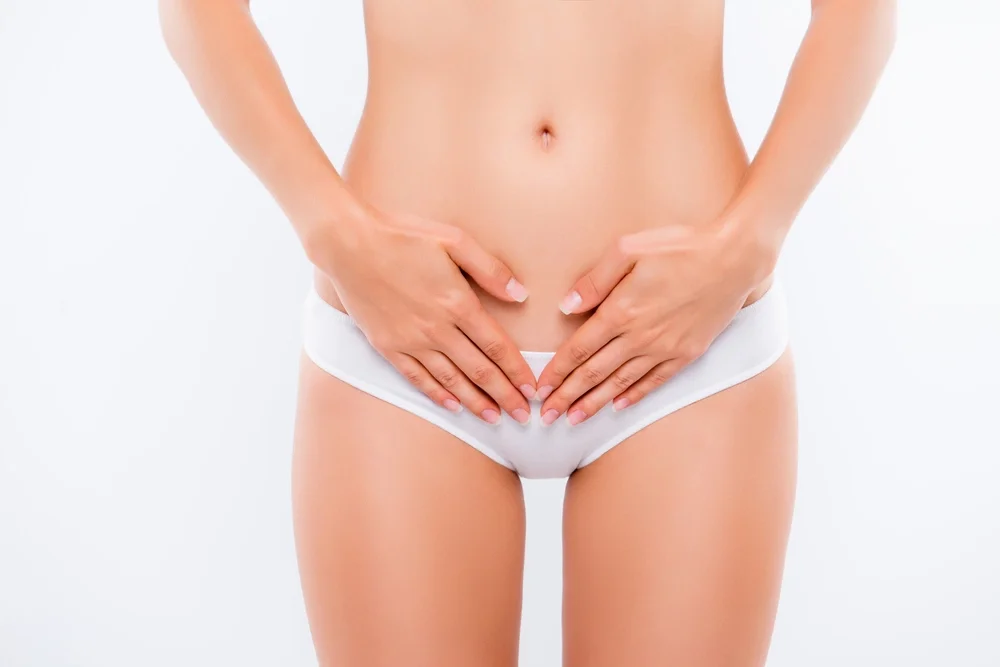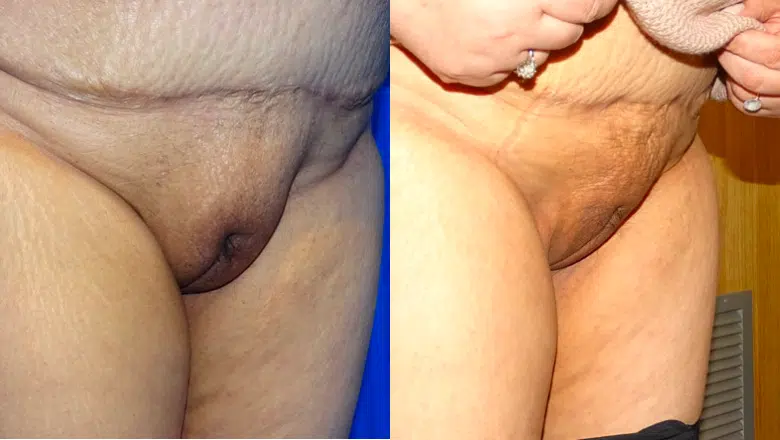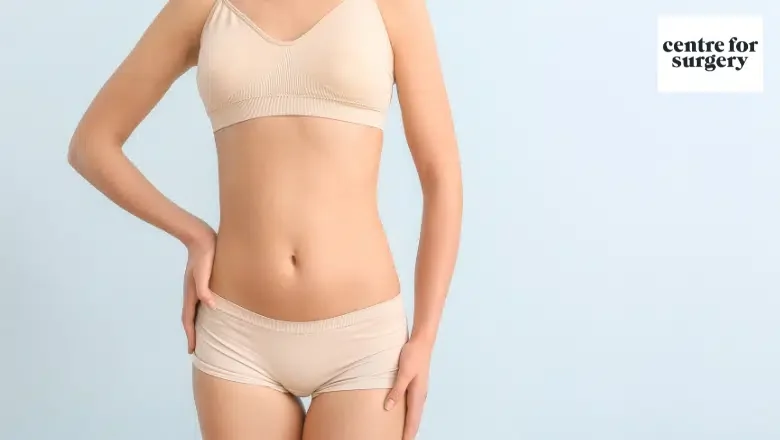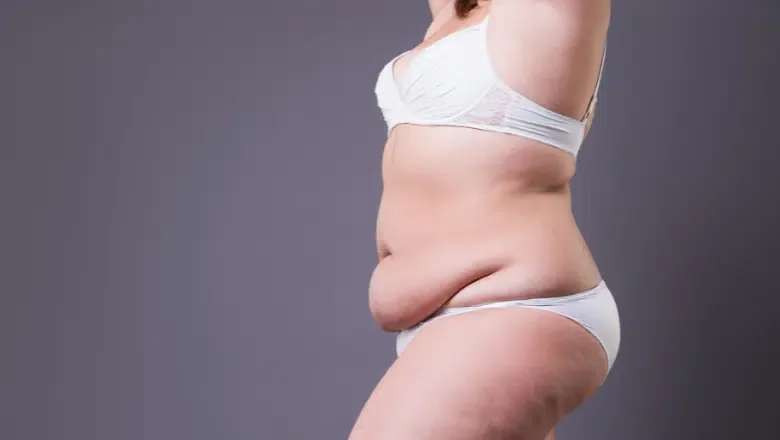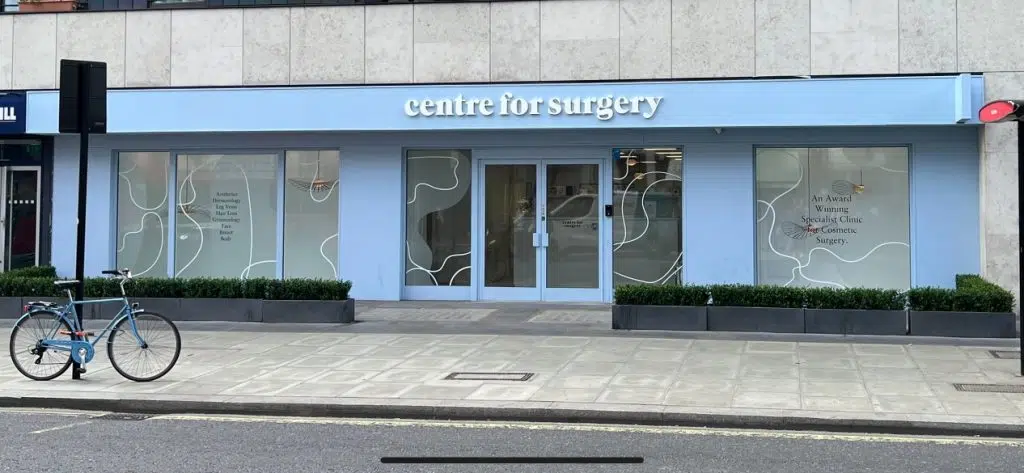The accumulation of fat in the upper pubic area, commonly referred to as FUPA (Fat Upper Pubic Area) or a ‘bulging mons,’ is a particularly stubborn type of fat deposit that tends to gather just below the bikini line. This area can be challenging to target with diet and exercise alone, leading many people to consider surgical options for more targeted fat removal. Several surgical procedures are designed specifically to address this issue, including monsplasty, panniculectomy, and abdominoplasty. For those looking for less invasive options, treatments like liposuction are also available and can be effective in reducing the appearance of a FUPA by toning the upper pubic area.
While adopting a healthy diet and a consistent exercise routine can help you lose weight generally and may slightly improve the appearance of your lower abdomen, these lifestyle changes are usually not sufficient for eliminating the fat concentrated in the upper pubic area. In many cases, surgical intervention is the most effective way to achieve significant, targeted results.
At Centre for Surgery, we specialise in plastic surgery and body contouring procedures. Our team of highly skilled surgeons collectively brings over 20 years of experience to the table, focusing on procedures specifically aimed at eliminating issues like FUPA. They regularly perform monsplasty, panniculectomy, abdominoplasty, and liposuction, offering a range of options to suit individual needs and preferences. Our clinic, situated in the heart of London, is equipped with state-of-the-art technology, and our team is committed to providing exceptional patient care from consultation through to post-operative recovery. With Centre for Surgery, you’re not just getting a surgical procedure; you’re investing in a comprehensive, personalised care package designed to help you achieve the best possible results.
What is FUPA?
FUPA stands for “Fatty Upper Pubic Area,” and it gained mainstream attention when pop superstar Beyoncé mentioned her own “mummy pouch” in an interview back in 2018. FUPA generally refers to the area of fat that accumulates just below the bikini line, around the mons pubis. This can happen due to a variety of factors, such as pregnancy, C-sections, and weight loss or gain.
The fat in this area can be particularly stubborn and resistant to traditional weight loss methods. While it’s often considered a cosmetic issue, leading to a bulging effect that many find unappealing, FUPA can also be associated with medical concerns. Excess fat in the area can lead to skin irritation, inflammation, and even the formation of ulcers. Additional issues can include excessive sweating and unpleasant odours.
Due to its stubborn nature, FUPA may require specialised treatments for effective reduction. Depending on the severity and individual circumstances, these can include targeted exercise, dietary changes, or surgical interventions such as liposuction.
What Causes a FUPA?
There are several recognised causes of FUPA, including:
Genetics
Hereditary factors have a strong influence on the development of FUPA. The distribution of fat in the body is often determined by genetics. Some people are more likely to develop excess belly fat while other people may be more likely to develop flabby arms or develop excess fat in the upper pubic area, leading to bulging mons. The genetic composition also plays a part in how fat is lost when people exercise regularly and eat a healthy diet. Diet and exercise often fail on their own to get rid of fat from stubborn areas of the body, such as the mons pubis. Fortunately, liposuction is an excellent cosmetic surgery procedure to get rid of excess fat that has proven resistant to diet and exercise.
Pregnancy
Pregnancy results in several changes affecting the physiology of the female body. The distribution of fat may begin to change due to hormonal factors. Many women often had great difficulty in getting rid of the post-pregnancy pouch after childbirth. A bulging mons pubis can affect wearing certain types of clothes. Fortunately, FUPA can be effectively treated with mons pubis liposuction in those who have good skin elasticity or with a monsplasty to help achieve a flatter mons pubis.
Significant weight gain or loss
People who gain significant amounts of weight in a short space of time often accumulate excess fat in unwanted areas of the body. Significant weight gain is one of the most common reasons for bulging mons pubis. Significant weight loss can also result in the development of loose skin affecting the mons pubis, which may also cause FUPA.
Understanding FUPA: A Concern for Both Women and Men
FUPA isn’t a problem exclusive to one gender. Indeed, anyone can experience a buildup of fat in this area, with women perhaps noticing it more, especially following pregnancy. The reasons behind developing a FUPA are mostly the same for both men and women. These include natural genetic factors, changes in weight, the ageing process, and shifts in hormone levels. However, the impact and appearance of FUPA can differ between genders due to the unique aspects of male and female bodies.
For women, pregnancy and giving birth are often pivotal moments that lead to the development of a FUPA. This is because the abdominal muscles stretch, and the skin expands to accommodate the growing baby, coupled with the body’s tendency to store extra fat in the pubic region for the baby’s protection and development.
On the other hand, men might notice the appearance of a FUPA as they gain weight, grow older, or experience changes in hormone levels, such as a decrease in male hormones. These factors can affect how fat is distributed across the body and the overall muscle mass, contributing to the formation of a FUPA.
Best Ways to Get Rid of Pubic Fat
Surgery is the best way to get rid of FUPA permanently. However, some people may achieve success through diet and exercise. Most people often fail to achieve significant improvement with non-surgical methods alone. This is because the fat in the pubic area is known to be a particularly stubborn form of fat. Whether fat has accumulated due to pregnancy or significant weight loss, surgery in the form of monplasty or liposuction is considered to be the most effective treatment.
In some cases, the best results are achieved by combining surgical techniques to achieve a permanent reduction of FUPA. Liposuction combined with excess skin removal is often the best way to get rid of bulging mons.
Monsplasty
A monsplasty, also known as a pubic lift, is a targeted surgical procedure designed to address issues with the fatty upper part of the genital area—commonly referred to as FUPA or the mons pubis. Here’s a quick rundown of what the surgery entails and the benefits you can expect:
The Procedure
During a monsplasty, your surgeon will perform the following steps:
- Remove extra fat and tissue from the mons pubis area.
- Eliminate excess skin.
- Tighten the underlying muscles and tissues.
The Results
The primary goal of monsplasty is to reduce the prominence of the mons pubis, thereby sculpting and contouring the area for a more streamlined appearance. This procedure can effectively eliminate your FUPA, leading to a smoother and more aesthetically pleasing upper pubic area.
Additional Benefits
Apart from the aesthetic improvements, monsplasty also offers functional advantages:
- Improved Hygiene: By removing the excess tissue and skin, you’ll find it easier to maintain cleanliness in the genital area, thereby reducing the risk of rashes and infections.
- Enhanced Sexual Comfort: A less bulky mons pubis can make sexual intercourse more comfortable.
- Easier Urination: The removal of drooping tissue can facilitate easier urination.
Comprehensive Makeover
A monsplasty or mons pubis liposuction can often be part of a more extensive “mummy makeover,” which may include other procedures such as breast augmentation, tummy tucks, vaginal rejuvenation, and more. This comprehensive approach aims to help you regain your pre-pregnancy physique, offering both functional and aesthetic benefits.
RELATED: Mummy Makeover After Massive Weight Loss
The procedure can be particularly beneficial for individuals who experience discomfort or functional issues due to the size or prominence of their mons pubis. It can be a game-changer in terms of both looks and quality of life.
Abdominoplasty
An abdominoplasty, commonly known as a tummy tuck, is an expansive surgical procedure designed to dramatically improve the appearance and tone of your abdomen. This surgery is far-reaching in its scope, focusing not just on removing stubborn belly fat but also addressing excess skin, while tightening the underlying abdominal muscles for a more sculpted look.
What the Procedure Entails
During an abdominoplasty, the surgeon meticulously removes extra fat and tissue from the stomach area, which often includes the sides, back, and even the hips. This comprehensive approach ensures that the tummy area is not only slimmed down but also appears more contoured and toned. Moreover, loose skin that may have resulted from weight fluctuations, pregnancy, or aging is also eliminated to give your abdomen a more youthful appearance.
The surgery may also involve a tightening of the abdominal muscles. This is particularly beneficial for those who have experienced separation of the abdominal muscles due to pregnancy or weight gain. The muscle tightening adds another layer of sculpting, enhancing the tummy’s overall tone and giving you a firmer, flatter abdomen.
Comprehensive Abdominal Makeover
Abdominoplasty can often be combined with other procedures for more holistic results. For instance, our surgeons frequently recommend coupling an abdominoplasty with a monsplasty, which focuses on the mons pubis area. By doing both procedures simultaneously, it is possible to address cosmetic and functional concerns across the entire abdominal region, including the mons pubis, achieving a more harmonious and proportionate outcome.
The Benefits
- Aesthetic Improvement: The procedure significantly enhances the appearance of the stomach by removing excess fat and skin, making it flatter, firmer, and more contoured.
- Muscle Tone: Tightening the abdominal muscles improves appearance and enhances functional core strength, which can be beneficial in daily activities and overall posture.
- Comprehensive Approach: The possibility of combining an abdominoplasty with other procedures like monsplasty allows for a more cohesive and comprehensive improvement in the abdominal area.
- Increased Self-Confidence: The significant cosmetic improvements often lead to an increase in self-confidence and overall well-being, as you feel more comfortable in your skin and clothing fits better.
An abdominoplasty is a powerful surgical tool for anyone looking to transform the appearance and functionality of their abdomen. It’s not just about slimming down; it’s about reshaping and rejuvenating your entire midsection for a more balanced and attractive physique.
Panniculectomy or Apronectomy: What It Is and How It Differs
A panniculectomy, also commonly referred to as an apronectomy or lipectomy, is a surgical procedure tailored specifically to address the removal of excess fat and skin from the lower abdominal area, which can include the upper pubic region as well. This procedure is particularly useful for individuals who are dealing with an overhanging ‘apron’ of skin and fat that can extend below the waistline, causing both cosmetic and functional issues.
Key Features and Differentiating Factors
Scope of Treatment
While a monsplasty focuses exclusively on the reduction and contouring of the upper pubic area, a panniculectomy has a broader scope. It aims to remove excess fat and overhanging skin from the lower belly, potentially including fat flaps and skin rolls that can accumulate at the base of the abdomen.
What It Addresses
The procedure is especially beneficial for those who have experienced significant weight loss, leaving them with an “apron” of loose, sagging skin and fat around the lower abdomen. This overhang can cause a range of issues, from skin irritation and hygiene difficulties to mobility problems.
Muscle Tightening
Unlike an abdominoplasty, which also includes tightening of the abdominal muscles for a more sculpted look, a panniculectomy focuses solely on the removal of excess skin and fat. This means it addresses the cosmetic and functional problems associated with a sagging lower abdomen but doesn’t offer the muscle-tightening benefits that an abdominoplasty would provide.
The Benefits of Panniculectomy
- Cosmetic Enhancement: The primary advantage is the significant improvement in appearance, eliminating the overhang and giving the lower abdomen a flatter, more toned look.
- Functional Gains: Removing the ‘apron’ can alleviate various problems like skin rashes, infections, and even issues related to mobility.
- Hygiene Improvement: By removing the overhanging skin and fat, it becomes easier to maintain cleanliness in the lower abdominal area, reducing the risk of skin irritations and infections.
- Clothing Fit: Post-surgery, clothes are likely to fit better, leading to increased self-confidence and comfort.
While a panniculectomy and abdominoplasty may seem similar, they serve different needs and offer distinct benefits. Knowing the specific outcomes and limitations of each can help you make an informed decision about which procedure is the most suitable for your unique circumstances.
Pubic Liposuction (FUPA Lipo)
Pubic liposuction, often referred to as FUPA Lipo, is another treatment option for those concerned about excess fat in the upper pubic area. This procedure is generally less invasive than a monsplasty or panniculectomy, focusing solely on the removal of fatty deposits through suction techniques.
What It Entails
Pubic liposuction involves using a cannula—a thin, hollow tube—and a suction device to remove excess fat. The surgeon will make small incisions in the targeted area and move the cannula back and forth to loosen and vacuum out the fat. This process allows for the selective removal of fatty tissue, making it possible to sculpt the area more precisely than other, more invasive surgical techniques.
Ideal Candidates
The ideal candidate for pubic liposuction is someone who has a small to moderate amount of excess fat in the upper pubic area but does not have significant skin laxity or muscle looseness. If you’re primarily concerned with a fatty bulge but do not have overhanging skin or muscular issues, this may be the most appropriate treatment for you.
Benefits and Limitations
- Benefits: Less invasive, quicker recovery time, and potentially less scarring compared to surgical procedures.
- Limitations: Does not remove excess skin or tighten muscles, less effective for those with a larger amount of excess fat.
Combined Approaches
In some cases, liposuction can be combined with other procedures, such as a monsplasty, to address both the fatty deposits and excess skin. This allows for a more comprehensive approach, treating both the volume and the skin laxity of the upper pubic area for a more aesthetically pleasing and functionally effective result.
As with any medical procedure, a thorough consultation with your surgeon will be necessary to evaluate your specific needs and concerns, and to develop the most effective treatment plan for you.
Non-invasive fat reduction
Non-surgical fat reduction techniques are less effective in getting rid of FUPA, although they may be preferred by certain patients who are not keen on the idea of invasive surgery. Laser fat reduction and laser skin tightening involve applying a specialised laser to the skin to target underlying subcutaneous fat and tighten the skin at the same time by stimulating the formation of new collagen. Non-surgical fat reduction has the advantage of being carried out as an outpatient procedure and does not involve any prolonged recovery. Non-invasive fat reduction does have its limitations in that it can only achieve a modest reduction in fat compared with mons surgery.
Recovery after FUPA surgery
FUPA surgery is a day-case procedure, which means you can go home later the same day. Having a mild degree of bruising, swelling and discomfort for the first 3 to 4 days after surgery is normal. After week one, most of the side effects will have settled down. It is important to take the prescription medications as directed by your surgeon, as this will help you to achieve a smooth recovery. Make sure to attend all of your post-operative review appointments and follow all of your surgeon’s postoperative instructions fully. Full healing should occur in six weeks, and patients can then return to their normal activities.
How to Get Rid Of FUPA Naturally?
Spot reduction, or losing fat in just one specific area of the body, is not possible through natural means. However, a well-rounded approach involving both diet and exercise can help you reduce overall body fat, which may lead to improvements in the upper pubic area, colloquially known as FUPA (Fat Upper Pubic Area).
Dietary Changes
- Caloric Deficit: The most crucial aspect of fat loss is creating a caloric deficit, where you consume fewer calories than you burn. This can be achieved by reducing your food intake or increasing your physical activity.
- Nutrient-Dense Foods: Opt for foods that are rich in essential nutrients but low in calories, like fruits, vegetables, lean proteins, and whole grains.
- Stay Hydrated: Drinking enough water can help you feel full and reduce unnecessary snacking.
- Avoid Sugar and Processed Foods: These can lead to weight gain and also contribute to fat storage in unwanted areas.
Lifestyle Changes
- Consistency: Consistency is key in any weight loss journey. Make sure to stick to your diet and exercise plan.
- Sleep: Lack of sleep can lead to weight gain and increased stress, which can negatively impact your ability to lose weight.
- Stress Management: High levels of stress can trigger the body’s “fight or flight” response, releasing hormones like cortisol that can contribute to fat storage.
Additional Tips
- Cardiovascular Exercise: In addition to targeted exercises, consider incorporating cardiovascular exercises like running, swimming, or cycling to help with overall fat loss.
- Strength Training: This helps build muscle, which in turn increases your metabolic rate, helping you burn more calories even at rest.
- Professional Guidance: A physical trainer or a registered dietitian can provide personalised advice tailored to your needs.
While it is unrealistic to expect that you’ll lose fat in your upper pubic area exclusively, these guidelines can help you reduce overall body fat and potentially improve the appearance of your FUPA. Remember, significant changes take time and effort, so be patient and consistent. If after committing to a natural approach you find that you’re not achieving the results you desire, you may then consider medical interventions such as the procedures mentioned earlier. Always consult a healthcare provider for advice tailored to your individual needs.
Lifestyle changes can help get rid of your FUPA – Diet and Exercise
There are key elements that can make a significant difference when it comes to reducing overall body fat, which in turn can help improve the appearance of your upper pubic area, or FUPA. Here’s a bit more detail on how these lifestyle changes can impact your results.
Diet Changes for FUPA Reduction
- Portion Control: Understanding serving sizes and reducing your portions can make a big difference in your calorie intake. The less you eat, the fewer calories you’ll need to burn to create a deficit.
- High-Quality Carbohydrates: Opt for whole grains, legumes, and other high-fiber carbs that help keep your blood sugar stable, unlike white bread and sugary cereals, which can lead to weight gain.
- Limit Alcohol and Beverages High in Sugar: Both alcohol and sugary beverages can contribute to abdominal fat. Drinking water, herbal teas, or low-calorie beverages can keep your calorie count down.
- Meal Timing: Eating regular meals and healthy snacks can help you control your hunger and make better food choices.
Exercise for FUPA Reduction
- Cardiovascular Exercise: As you mentioned, cardio is essential for overall fat burning. Aim for at least 150 minutes of moderate-intensity cardio per week, as per the American Heart Association guidelines.
- High-Intensity Interval Training (HIIT): This type of training involves short bursts of intense exercise followed by rest or lower-intensity exercise. HIIT has been shown to burn more calories in less time and increase metabolic rate even after the workout is done.
- Strength Training: Don’t underestimate the power of muscle when it comes to burning calories. More muscle means a faster metabolism, which can help with weight loss.
- Variety in Workout: It’s important to mix up your workout routines to prevent boredom and plateaus. Include different types of activities and sports to keep things interesting and challenge different muscle groups.
Monitoring and Adaptation
- Tracking: Use apps or a food diary to track your food intake and exercise. Knowing exactly where you stand can help you make necessary adjustments to your lifestyle.
- Regular Check-ups: Periodic measurements of your waistline, weight, and other areas can help you understand whether your efforts are paying off and what else needs to be done.
- Adapt and Evolve: As you make progress, your caloric needs may change, and your exercise routine may need to be adjusted. Stay informed and adapt your lifestyle changes accordingly.
- Professional Help: Sometimes, a personal trainer or a dietitian can provide the extra guidance and motivation you need.
Making these changes part of your daily routine can not only help reduce your FUPA but also contribute to a healthier, more active lifestyle overall.
What Is The Best Way To Get Rid Of FUPA Naturally?
The best way to get rid of FUPA naturally would largely depend on a variety of factors, including your body type, metabolism, and lifestyle. However, there are several natural approaches you can try:
Natural Approaches
- Calorie Deficit Diet: Creating a calorie deficit by consuming fewer calories than you burn is the foundation of weight loss. High-protein, low-carb diets are often recommended for fat loss.
- Regular Exercise: Cardio exercises like jogging, cycling, and swimming can help burn overall body fat, while targeted exercises like planks and pelvic tilts can tone the lower abdominal area.
- Hydration: Drinking plenty of water can help with weight loss by promoting fullness and increasing calorie burning.
- Quality Sleep: Poor sleep is linked to weight gain, so make sure you’re getting 7-8 hours of good-quality sleep per night.
- Stress Management: Stress can lead to weight gain, especially in the abdominal area. Stress management techniques like meditation and mindfulness can help.
Limitations of Natural Methods
Although these methods can be effective for general weight loss and toning, they may not yield the same results as surgical procedures in removing fat from specific areas or tightening loose skin.
Surgical Procedures
- Monsplasty: This procedure removes excess fat from the pubic mound, offering a more targeted approach.
- Abdominoplasty: For those dealing with loose skin and fat in larger abdominal areas, a tummy tuck can be combined with monsplasty for a comprehensive solution.
- Liposuction: This can also be an option if you’re looking for less invasive procedures.
Post-Surgery Care
The results of surgical procedures are not a one-time fix. A post-procedure regimen involving diet and exercise is crucial for maintaining the results.
How Much Does a Monsplasty Cost?
When it comes to figuring out how much you’ll need to fork out for a Monsplasty, there’s no one-size-fits-all price tag. Several things can make the cost go up or down. Where the clinic is situated can make a big difference; some places just naturally cost more. The skill and experience of your surgeon also play a part—top-notch professionals might charge more, but they bring a lot of know-how to the table. The specifics of your surgery, including how complex it is, will affect the price, too. Plus, there are extra costs to consider, like the anaesthesia, the use of the clinic’s facilities, and any care you’ll need after the surgery.
We know it’s a lot to think about, which is why we recommend having a chat with one of our specialist plastic surgeons. They can give you a personalised quote that matches your specific needs and aims, helping you make an informed decision about your Monsplasty.
FUPA Surgery FAQS – Fat Upper Pubic Area
Here we answer your most commonly asked questions about monsplasty in London:
What does FUPA stand for?
FUPA, or the Fatty Upper Pubic Area, is basically the extra fat that sits just above your pubic bone. It’s the bit that can sometimes stick out a bit more than the rest of your tummy.
When Does the Pubic Fat Pad Go Away?
The short answer is, it’s different for everyone. Things like your genes, how you live your life, and your hormones all play a role. There isn’t a set age or time when you can expect it to just vanish. It’s all about your body’s unique way of handling fat.
Why Do I Have a ‘FUPA’ Even Though I’m Skinny?
You might be scratching your head, wondering why you’ve got a bit of a bulge in your upper pubic area even though the rest of you is rather slim. Well, it turns out your tummy and upper pubic area are pretty good at hanging onto fat, more so than other parts of your body. This is especially true if you’re not too active and you’re fond of foods that are high in sugar or are processed. Another reason could be down to your genes. Some folks are just naturally wired to store fat in their mons pubis, which means they can have a more pronounced upper pubic area even if they’re slender everywhere else.
What Can Slim People Do to Get Rid of Their FUPA?
If you’re already slim and don’t want to lose weight from other areas of your body, general weight loss methods like diet and exercise might not be your best bet. They can make you lose weight all over, which isn’t ideal if you’re already lean. A monsplasty, or a pubic lift, could be just what you need. This is a surgical procedure that zeroes in on the excess fat in your upper pubic area. It can get rid of the bulge without affecting your overall weight. So if you’re slim but still dealing with a FUPA, a monsplasty could offer a more targeted solution.
Can a monsplasty be combined with a tummy tuck?
A monsplasty is very commonly combined with an abdominoplasty, although a tummy tuck can also be carried out on its own if you do not have a bulging mons. A tummy tuck in the presence of FUPA may make a bulging mons pubis look more obvious. Your surgeon may recommend combining FUPA removal and a tummy tuck in the same procedure.
Is mons pubis reduction painful?
Monsplasty is most commonly carried out under general anaesthetic, which means you will not be able to feel anything during the procedure. Your surgeon will prescribe painkillers for you to take after the procedure, which means you should only experience mild discomfort for the first few days at most.
When can I go back to work after monsplasty?
Most patients can return to work after one week. People who have physically demanding occupations may be recommended to take two weeks off work.
When will I see the results of monsplasty surgery?
Results of mons pubis reduction will be visible immediately after the procedure, although postoperative swelling will take between 4 to 6 weeks to disappear. Once most of the swelling has disappeared by six weeks, you will be able to see the final results of monsplasty surgery.
Will I have visible scars after mons pubis reduction?
Our surgeons are experts in positioning incisions in natural creases and body folds to minimise scarring. All surgical incisions will result in the formation of a scar, and there is no way to prevent scarring completely. Your surgeon is experienced in scar minimisation techniques after surgery, including silicone gel and scar massage to produce flatter scars.
Can men have FUPA?
Men commonly request surgery for FUPA, although women are more likely to develop it than men. Some men may be genetically predisposed to develop FUPA, which is more likely to occur when excess weight is gained. A bulging mons in men may lead to the development of a buried penis. Mons pubis reduction in men is ideal for creating a flatter pubic area which will help to give the impression of a larger penis due to the removal of fat around the base of the penis.
Can Losing Weight Get Rid of FUPA?
Losing weight can definitely make your FUPA smaller because it reduces the amount of fat your body is carrying overall. However, you can’t choose to lose fat from just the FUPA area alone. If you’re looking to target the FUPA specifically, you might have to consider treatments or even surgery designed for that area.
How Can I Dress to Make FUPA Less Noticeable?
If you’re trying to keep your FUPA under wraps, your wardrobe can be a great ally. High-waisted items can work wonders by smoothing out the area. Clothes that have a bit of flare or are a tad baggy can also help by not clinging too tightly, making the FUPA less obvious.
Can I get a mons pubis reduction on the NHS?
Mons pubis reduction is considered a type of cosmetic surgery, and the NHS does not provide funding for any type of cosmetic surgery. The best way to get treatment for FUPA is by choosing a reputable private clinic such as Centre for Surgery in London.
What is the difference between Liposuction and a Tummy Tuck?
When it comes to choosing between Liposuction and a Tummy Tuck, understanding the fundamental differences between these two popular procedures is crucial, especially regarding their objectives and techniques.
Liposuction is all about fat removal. It targets specific areas of your body where fat tends to accumulate, like the abdomen, thighs, or arms, with the main goal being to reshape and contour these spots. If you’re generally happy with your skin’s elasticity and don’t have issues with loose skin or muscles, Liposuction might be the way to go. However, it’s important to note that Liposuction won’t help with excess skin or do anything to tighten your abdominal muscles. It’s purely a fat removal technique.
On the other hand, a Tummy Tuck goes several steps further. Not only does it remove excess fat, but it also deals with extra skin that can often be left hanging after significant weight loss or pregnancy. If that’s not enough, a Tummy Tuck often involves tightening the abdominal muscles, providing a more toned and defined abdominal area. It’s a comprehensive approach for those looking to improve their abdominal profile significantly.
Why Choose Centre for Surgery for Your FUPA Surgery?
Deciding on the right clinic for any cosmetic procedure is a crucial decision. At Centre for Surgery, we pride ourselves on delivering not just exceptional surgical outcomes, but also a comprehensive and personalised care journey.
Our Surgeons
Our surgeons are highly qualified and specialists in their respective fields. They are registered with the General Medical Council and are regularly audited for their professional standards. This ensures that you will be in the safest hands, receiving a world-class procedure designed to meet your individual needs.
Advanced Surgical Techniques
We employ state-of-the-art surgical technologies and techniques to ensure minimally invasive yet highly effective procedures. Our approach ensures that recovery time is as short as possible while delivering the best possible results.
Patient Care
From your first consultation to post-operative check-ups, our dedicated team of nurses and coordinators will provide a high standard of care, making sure you are well-informed and comfortable throughout your journey with us.
Patient Testimonials
Don’t just take our word for it, listen to our satisfied patients:
- “I had my FUPA surgery at Centre for Surgery and the results are simply outstanding. My confidence has skyrocketed!” – Sarah, London
- “My experience was seamless from start to finish. The staff are incredibly friendly, and the surgeon was professional and attentive.” – Mark, Birmingham
- “I’m thrilled with the results. The aftercare was excellent, and my recovery was much smoother than I anticipated.” – Emily, Leeds
Consultation Booking
Ready to take the next step? Book your consultation with us today:
- Phone: 0207 993 4849
- Email: contact@centreforsurgery.com
- Address: 95-97 Baker Street, London W1U 6RN
For more information, tips, and insights into FUPA surgery and other cosmetic procedures, don’t forget to check out our comprehensive Plastic Surgery Blog.
We look forward to welcoming you at Centre for Surgery and helping you achieve your aesthetic goals.
